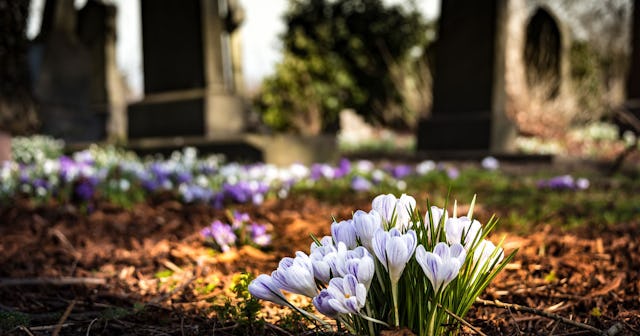How My Daughter's Death Changed The Way I Look At Cemeteries

Though it can have its heartbreaking moments, visiting the cemetery where my daughter is buried has been my way of taking an active role in my own grief. For a time, I was visiting multiple times a day. Some might say that’s unhealthy, but not to me. You see, it was, and is sometimes still, my way to cope.
The cemetery where she is buried is absolutely beautiful. Seated at the tip-top of a huge hill and surrounded by trees is where she lies in a place called “Babyland.” To tell you how much her resting spot is cared for, the groundskeeper’s wife (a family friend) hand-cuts the grass around all of the baby graves with scissors in the places where the riding lawnmower did not reach. She is a God-send and too good for this world.
Up until my daughter’s death, cemeteries had always creeped me out. But now that my daughter’s physical body rests in one, I view them quite differently. Kind of like the groundkeeper’s wife. For every headstone shown, and even the marked graves without, there is someone’s loved one. Whether their loved one has now joined them in ashes to ashes, dust-to-dust, or not, they were loved. Good person or not, they were loved. Flowers or no flowers on display, they were loved.
But somehow in America, cemeteries have evolved into a taboo destination unless it’s a solemn visit or funeral. Meanwhile, in some cultures, there are holidays to remember and honor deceased loved ones, such as Dia de los Muertos (Day of the Dead). In Denver, some cemeteries double as parks. And up until the beginning of the 20th century, America’s cemeteries weren’t so still and silent either.
In 18th and 19th century America, many children died before they were 10, if they even lived a day at all, and maternal mortality rates were alarmingly high. Infectious diseases such as cholera and yellow fever were sweeping our nation and killing our people. Therefore, cemeteries became a sort of safe haven for the bereaved to openly share their grief with others who understood, while also being surrounded by both living and deceased loved ones.
In one Grand Rapids 1885 newspaper clipping, one reporter wrote that he was greeted in a cemetery on Thanksgiving day by a bereaved family after the loss of their father and husband not even six months prior. The younger son said to the man, “We are going to keep Thanksgivin’ [as my Father] was live and hearty this day last year, and we’ve brought something to eat and a spirit lamp to boil coffee. You don’t mind our making ourselves comfortable, and I think there’s enough to find you a bite anyways.”
The author of the article reflected on his time with the family by writing, “I felt thankful, somehow, as I watched that family [making a sort of] sacred picnic out of their grief, ‘leastways, I don’t know what else to call the lump [that] rose in my throat.”
This soothing take on grief is due, in part, to the revitalization of cemeteries, which kicked off alongside the rural cemetery movement — an initiative placing cemeteries outside city limits instead of on church grounds. Keith Eggener, associate professor of American art and architecture at the University of Missouri, tells The Atlantic that old church burial grounds were beginning to be viewed by the public as “inadequate, dangerous, crowded, expensive to maintain and carriers of disease.”
Back then, headstones, if the family could afford them, showed unpleasant images such as skulls and Father Time extinguishing the light on life’s candle. Cemeteries were dreary places to visit, offering nothing but a chilling reminder of death. Therefore, they weren’t a place that anyone desired to visit, let alone picnic.
Konstantin Pudan/Unsplash
But the rural cemetery movement changed this by beautifying cemetery lands and the headstones of those buried within their walls. The dark and unknown was opened with “winding roads and picturesque vistas,” offering a serene getaway for nearby civilians … much like the cemetery where my daughter is buried.
Public parks weren’t around during this point in American lifestyle, but cemeteries’ park-like attraction created social gatherings among thousands of individuals on hundreds of acres of land. Holidays, special occasions, or even an after-church Sunday picnic were all common on cemetery grounds.
But with this kind of attention, there also came a downfall for the newly-constructed, adorned and beautiful grave sites. Litter. One newspaper clipping stated, “A remarkable fad sprang up in Denver of going to the cemeteries for the picnics. It became such a nuisance to have thousands strew the grounds with sardine cans, beer bottles and lunch boxes that police interference was contemplated.”
Photo by DDP/Unsplash
But then the reporter noted they appeared “happy under distressing circumstances,” and law enforcement ultimately turned a blind eye because it was “worthy of cultivation.”
In the 20th century, however, the tradition of picnicking in the cemetery became less common as the life expectancy increased and public park space expanded. Although cemeteries in America today remain silent for the most part, some cultures continue to keep the tradition of picnicking at the cemetery alive.
For some, much like me, it might be exactly what gives them a touch of comfort during the many discomforting stages of grief. For others, it might just mean that it’s the perfect remote place to walk their dogs. Whatever it may be, there’s nothing wrong or “creepy” about finding a sense of peace and solace on cemetery grounds. Just don’t forget to respect those who have gone before you and clean up after yourself.
This article was originally published on